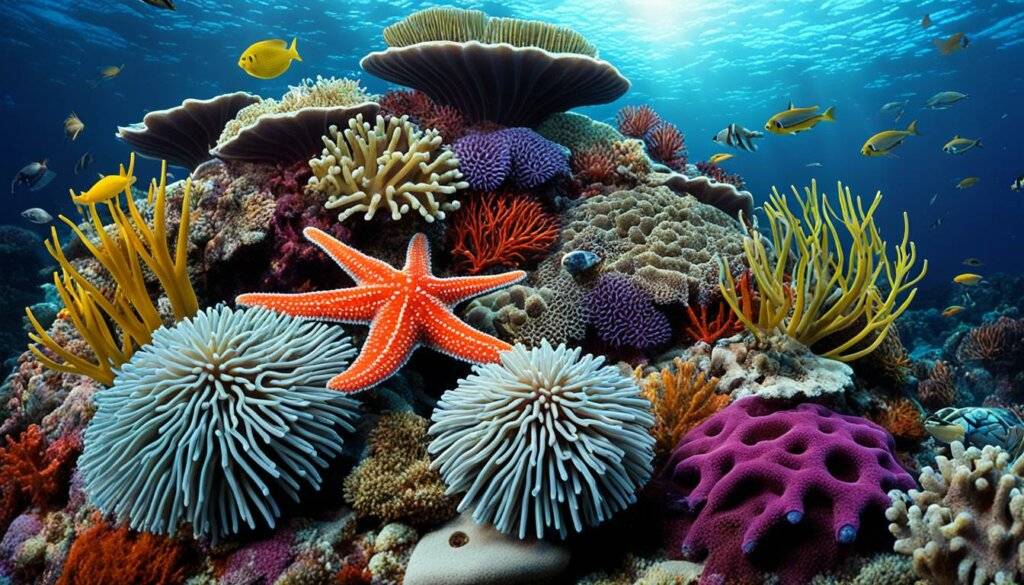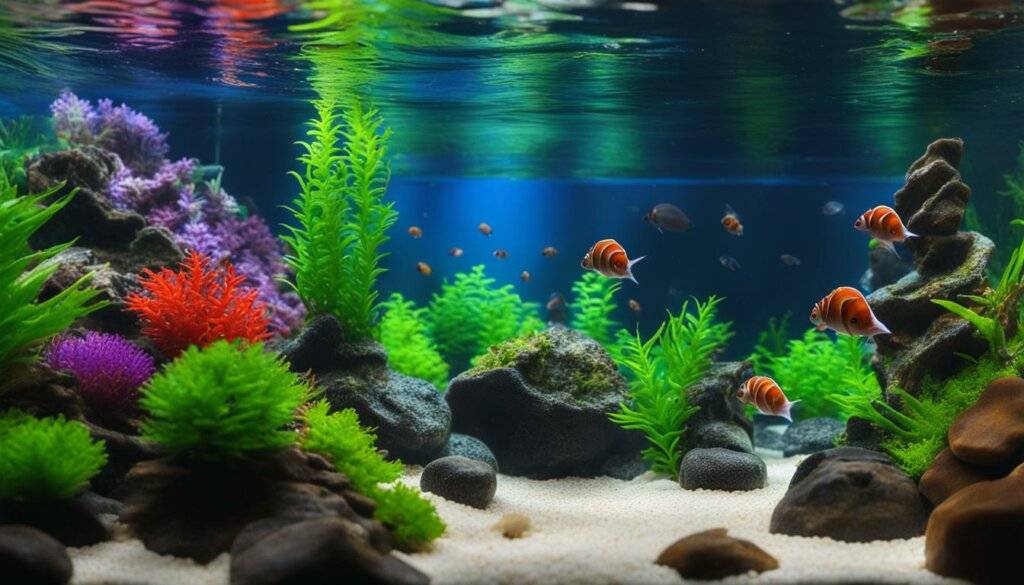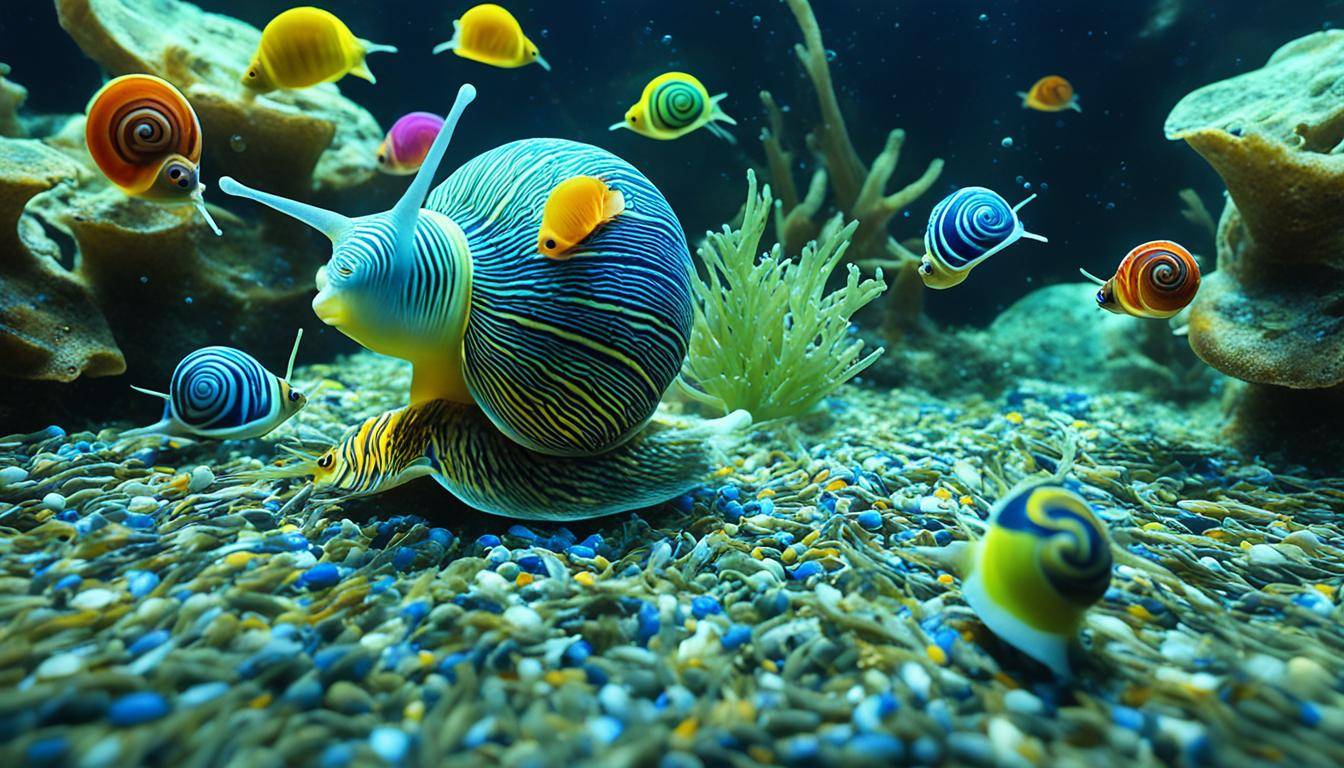Imagine entering a room that’s full of vibrant colors and soothing water sounds. You see a diverse range of marine life delicately swimming in a mini underwater world. Your aquarium is more than just a pretty sight. It’s a thriving ecosystem that needs careful attention to stay clean and balanced.
Turbo snails are your allies in fighting off algae and waste. These small creatures are a huge help in keeping your tank fresh. They are working hard behind the scenes to make your aquarium a healthy place.
Just like a top-notch cleaning crew, turbo snails are pros at battling algae and keeping tanks clean. They love to eat algae, which is great for you. It means they’re an eco-friendly solution to fighting off too much algae in your aquarium.
But, just how do turbo snails do their crucial job? Let’s explore the fascinating role these snails play in keeping aquariums clean and pure.
The Role of Snails in the Cleanup Crew
Snails are key to a clean and healthy aquarium. Species like Astrea, Turbo, Margarita, Cerith, and Nassarius eat different kinds of algae. This makes them great algae eaters.
They help keep the tank clean by eating algae. Each kind of snail cleans a different part of the tank. This means your tank stays spotless, from the glass to the hard-to-reach spots.
They’re the “janitors” of your tank. By eating algae, they stop it from spreading too much. This keeps your tank’s ecosystem in balance. And it’s all done naturally.
Snails make your tank look good by controlling algae. Their constant grazing keeps everything pretty.
With snails, you spend less time cleaning. They eat algae as part of their natural behavior. So, the tank stays clean without you doing a lot of work.
Having many snail types makes your tank even cleaner. Each kind has its favorite algae to eat. This creates a perfect balance for your aquarium.
Benefits of Snails in the Cleanup Crew:
- Efficient algae eaters that keep the tank clean
- Natural and eco-friendly solution for algae control
- Reduces manual cleaning effort
- Preserves the overall aesthetics of the tank
- Creates a cleaner and healthier environment for tank inhabitants
Snails are powerful for a clean and beautiful tank. They’re great at cleaning and controlling algae. This makes for a pretty and healthy aquarium for your fish.
Other Members of the Cleanup Crew
More than just snails, there are other cool creatures for your tank cleanup. They help keep the water clean, fight off algae, and make sure your fish have a good home. Here are some of those neat helpers:
Echinoderms
Urchins, starfish, and brittle stars are both pretty and very helpful. Urchins eat algae and dead bits with their many feet. Starfish clean up leftover food and they take care of decaying stuff. Brittle stars are great for stirring sand, which stops waste from building up.
Crabs
Hermit crabs and emerald crabs are important for cleaning too. Hermit crabs eat up uneaten food and help keep the sand in good condition. Emerald crabs love to eat bubble algae, which makes them awesome team players.
Shrimp
Cleaner shrimp are like the superheroes of the tank. They are super clean and they pick parasites off the fish. These little guys work hard to keep everyone healthy and free of pests.
With echinoderms, crabs, and shrimp on your team, your tank stays in top shape. They all do their part in taking care of waste, stopping algae, and keeping the place clean for fish.

-
Save
These special creatures make your aquarium not just beautiful, but they also work as your tank’s cleaning crew. Let’s dive deeper into the benefits of having a cleanup crew in the next part.
Benefits of Having a Cleanup Crew
A cleanup crew is essential for a clean, healthy aquarium. It’s important to understand the benefits they offer.
Promotes Natural Balance
A variety of snails, crabs, and shrimp maintains your tank’s ecosystem. Each has a specialty in keeping the tank clean. This way, every corner gets the attention it needs.
“A well-balanced cleanup crew is like a professional janitorial team for your aquarium, maintaining a pristine environment through their specialized cleaning abilities.” – Jonathan, experienced aquarist
Efficient Waste Management
The crew, including snails, works hard to remove waste. They eat detritus and leftover food, stopping it from spoiling the water. This leaves the tank clean and safe for your fish.
Controlled Algae Growth
Algae growth is a common challenge for aquarium owners. Luckily, the cleanup crew includes algae eaters. Snails are excellent at keeping algae under control, making your tank look better.
Reduced Maintenance
With a good cleanup crew, you’ll need to clean or change water less often. They keep the tank walls free from grime. This saves you time and makes caring for your aquarium easier.

-
Save
Clearly, a cleanup crew brings many benefits. From managing waste and algae to reducing your maintenance, they enhance your aquarium’s health. Investing in a diverse crew makes your tank a better home for your fish.
Conclusion
Turbo snails and other cleanup crew members are the real heroes of your tank. They help keep waste in check, control algae, and make sure the tank stays clean. A well-chosen cleanup crew is key to a healthy tank for all its inhabitants.
Adding a cleanup crew makes your tank both attractive and eco-friendly. They manage waste effectively, keeping the tank’s natural balance. And they cut down on the manual cleaning you’d otherwise need to do, making your life easier.
Having a mix of snails, echinoderms, crabs, and shrimp boosts your tank’s cleaning power. Snails are great at eating algae, keeping it under control. Other members like crabs and shrimp help with waste and detritus, keeping the ecosystem balanced.
A good cleanup crew is vital for a thriving aquarium. They manage waste and control algae, ensuring a healthy space for your fish. By choosing a variety of cleaners, you’ll have a well-maintained, beautiful tank to enjoy.
